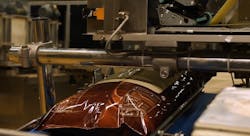How Real-Time Data Sharing and Collaboration Delivers Competitive Advantage
There’s been no shortage of news about how artificial intelligence is impacting manufacturing. But the development of AI, in general, offers lessons for the manufacturing industries in terms of how AI can provide a roadmap to innovation.
Here’s what I mean: AI is everywhere now because numerous scientists built on each other’s work. Such collaboration is key to moving the needle in science, but also in business. Anyone who’s ever attended a successful brainstorming meeting knows that working together helps solve tough problems and drive innovation. Today’s advanced industrial AI technologies present the opportunity to work together in new ways, enabling cross-company networks to drive efficiency, innovation and growth. By using AI in tandem with other data-driven technologies, we can radically transform the concept of collaboration.
With the industrial sector facing mounting challenges, the future of growth and innovation depends on such radical new approaches to collaboration — and not just within organizations but across entire sectors.
We now collect more data than ever. Global use next year will total an estimated 200 zettabytes. Sharing that data and the resulting analytical and contextualized insights will be the foundation for creating value. With human direction, this industrial intelligence can enable businesses to transcend individual limitations, cut costs, improve efficiency, and accelerate product and process innovation.
Nearly half (45%) of the industrial companies polled in the recent Aveva Industrial Intelligence Index survey believe platforms that enable real-time data sharing and collaboration will drive the greatest opportunity for their organizations. They recognize that sharing AI-infused insights can elevate human ingenuity. Instead of rebuilding industries from the ground up, businesses can leverage historical data and an overlay of artificial intelligence analytics to grow faster while staying responsive and flexible.
Chocolate manufacturer’s Barry Callebaut MES-centered example
With roots going back more than 150 years, chocolate manufacturer Barry Callebaut unlocked new gains that have helped them navigate complex processes and variable supply quality that change on a daily basis. The company employs a manufacturing execution system (MES) to unify existing HMI/SCADA plant data into a connected, real-time digital backbone. This standardized framework ensures that critical information is accessible to the appropriate teams across the organization. By leveraging this centralized "single source of truth" through an industrial data platform, teams can align their efforts with key value drivers and experiment with new use cases at strategically selected pilot sites.
The results of these pilot projects — both successes and lessons learned — are captured using a modular approach, enabling continuous refinement of the company’s smart factory standards. This method allows best practices to be efficiently shared and scaled across the company’s global operations, driving consistent improvement and innovation.
Battery manufacturer Verkor drives sustainable outcomes through collaboration
EV battery manufacturer Verkor wanted to make its operations more sustainable. But before implementing a collaborative approach to its digital transformation efforts, the company struggled to get a handle on their own efficiency and carbon footprint across their network of teams — from procurement to product to process.
The team found that infusing industrial data with AI-provided insights into production data they had not seen before, helped them to better analyze the energy impacts of the company’s production systems.
In a competitive discrete manufacturing environment such as EV production, this allowed Verkor to quickly scale up by reducing the complexity and risk of projects. They were able to focus on ensuring traceability and quality of product and production data, as opposed to working through silos of data and process. With such insights, Verkor operators are making better commercial and sustainability decisions.
Schneider Electric’s Smart Factory program boosts industrial efficiency
Deep partnerships rely on open, agnostic and interoperable systems to share data and analytics seamlessly with internal or external partners. Such an end-to-end view across the operating ecosystem enables real-time insights and rapid adoption of innovation across the ecosystem.
The Schneider Electric Smart Factory Program was founded with the vision of providing performance efficiency across its manufacturing operations portfolio to address common manufacturing pain points (e.g., energy efficiency, asset performance management, process efficiency, etc.). The program developed “lighthouse” sites to scale best practices, expertise and knowledge sharing, applying Industry 4.0 technologies to connect their operations from the shop floor to the top floor.
What the Smart Factory Program found to be most important for scaling their efforts and overcoming operational and asset performance pain points was involving their entire ecosystem, from technology providers to system integrators, in the planning and execution of manufacturing discussions.
Companies like Schneider Electric DERNetSoft and its partners show how radical collaboration can bring us closer to that target. Since the start of the program in 2020, they have been able to scale smart factory efforts and transform the global footprint of more than 100 connected factories, resulting in 44% less downtime and 21% energy efficiency savings.
Collaborative ecosystems are vital to industry’s future
As we have seen in these examples, the advantages of digital collaboration extend across the value chain — from design and engineering to greater energy efficiency.
Recent studies demonstrate the benefits of such an ecosystem approach. The majority (86%) of executives responding to an EY study believe that ecosystems will be a critical success factor in their industry. Likewise, 57% see a lack of ecosystems in their company’s strategy as a serious competitive disadvantage.
Collaborative ecosystems enable stakeholders to share insights, remove information silos and drive smarter decisions along the value chain. The future of industry lies in harnessing radical collaboration to drive innovation and adaptability.
Rob McGreevy is chief product officer at Aveva.
More coverage from Automation World on data-driven insights for manufacturers:
About the Author

Leaders relevant to this article:


